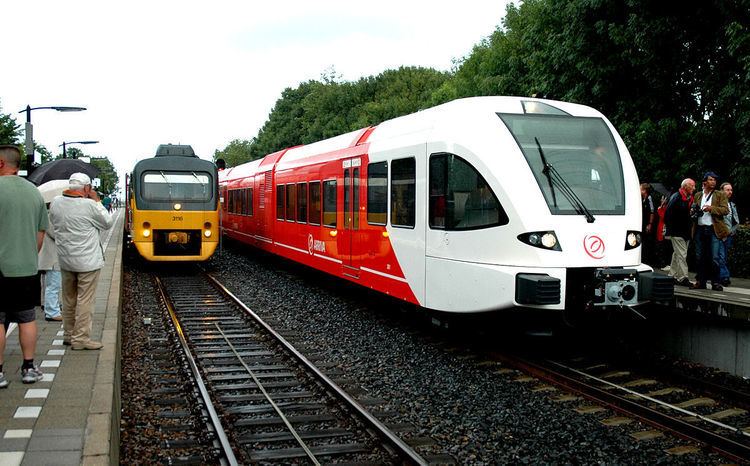Opened 1 November 1868 Platforms in use 2 | Connections Bus lines: 811, 817 Tracks 2 | |
 | ||
Similar Zuidbroek railway station, Scheemda railway station, Winschoten railway station, Grijpskerk railway station, Zuidhorn railway station | ||
Bad Nieuweschans ( [bɑt ˌniuʋəˈsxɑns]; abbreviation: Nsch), previously named Nieuweschans (1868–2013), is an unstaffed railway station in the village of Bad Nieuweschans in the Netherlands. It connects the Harlingen–Nieuweschans and Ihrhove–Nieuweschans railways and is situated between Winschoten in the Netherlands and Weener in Germany.
Contents
The station building was completed in 1867 and demolished in 1973. Train services started on 1 November 1868. Trains were operated by Staatsspoorwegen (1868–1937), Nederlandse Spoorwegen (1938–2000), NoordNed (2000–2005), and Arriva (2006–present).
The station has two tracks and two platforms. There are two local train services with trains every hour to and from Groningen and Leer (Germany). There are also two bus connections at the station provided by Qbuzz.
Location
The railway station is located at the Stationsstraat in the village of Bad Nieuweschans in the east of the province of Groningen in the northeast of the Netherlands. It is the easternmost station in the Netherlands and connects the Dutch railway network in the west with the German railway network in the east. The station is the eastern terminus of the Harlingen–Nieuweschans railway after Winschoten, which leads towards Zuidbroek and Groningen in the Netherlands. The Ulsda railway stop was between Winschoten and Nieuweschans between 1887 and 1938. The station is also the western terminus of the Ihrhove–Nieuweschans railway after Weener, which leads towards Leer in Germany. The distance from Bad Nieuweschans westward to railway terminus Harlingen Haven is 127 km (79 mi), to Groningen 46 km (29 mi), to Zuidbroek 25 km (16 mi), and to Winschoten 12 km (7.5 mi). The distance from Bad Nieuweschans eastward to Weener is 16 km (9.9 mi) and to railway terminus Ihrhove 24 km (15 mi).
History
The station building was completed in 1867. It was one of nine buildings in the Netherlands of the type SS Hoogezand etc designed by Karel Hendrik van Brederode. There was a customs office next to the station building. The segment of the Harlingen–Nieuweschans railway between Winschoten and Nieuweschans, as it was then called, was opened on 1 November 1868. The Ihrhove–Nieuweschans railway was opened on 26 November 1876. Trains were operated by Maatschappij tot Exploitatie van Staatsspoorwegen until 1937.
Georges Simenon's story Maigret and the Hundred Gibbets (1931) starts in this station. From 1938 to 2000, trains were operated by the Nederlandse Spoorwegen, which was formed when the Maatschappij tot Exploitatie van Staatsspoorwegen and the Hollandsche IJzeren Spoorweg-Maatschappij merged. During World War II, between 1942 and 1944, more than 102,000 people were transported from the Westerbork transit camp to Nazi concentration camps. Nieuweschans was the last station in the Netherlands they passed, which is commemorated with the sculpture De laatste blik (The Last View). The station building was demolished in 1973.
Trains service have been provided by NoordNed from 2000 to 2005, and by Arriva since 2006. On 15 December 2013, the village was renamed from Nieuweschans to Bad Nieuweschans and the station name was changed accordingly. In December 2015, a railway bridge near Weener was destroyed in a collision with the ship Emsmoon, and the Ihrhove–Nieuweschans railway has been closed since.
Station layout
The railway through Bad Nieuweschans is unelectrified and oriented west to east. At the station, the single-track railway splits into two tracks. There are two platforms, platform 1 is north of the northern track and platform 2 is south of the southern track. Beyond the station the tracks merge back into a single track.
Trains
There are two local train services (Dutch: stoptreinen, German: Regionalbahn), both operated by Arriva, that call at Bad Nieuweschans:
The 37500 service only continues to Bad Nieuweschans in the morning and in the evening.
Buses
At the station, there are two bus connections operated by Qbuzz with the following destinations:
